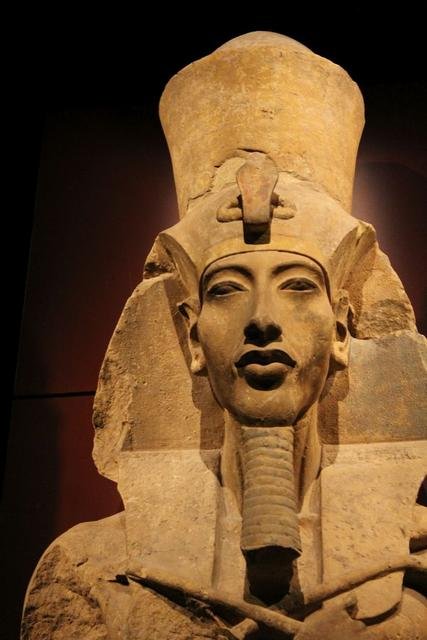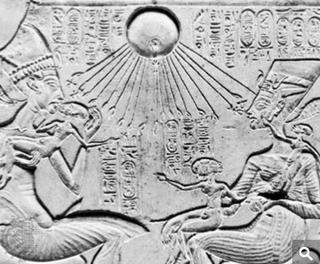Akhenaton: The pharaoh’s heritage
Often we commit the error of analyzing a historical figure without taking into account the environment in which he or she developed their life’s work. In the case of Akhenaton, even more than any other Egyptian Pharaoh, it is convenient to analyze what factors took him to try and sabotage one of the greatest and most lasting religious movements of the Egyptian empire. In my opinion, Akhenaton, is to be considered as today we consider an entrepreneur. For him to make his company, or in this case his empire, prosperous and suitable he not only had to have a decided spirit but also faith in the objective he was willing to accomplish. It is not easy to convince the entire population of Egypt to change religion. But why was there a need to change the faith of possibly the greatest empire at the time?

A clergy with too much power
Akhenaton’s great grandfather, Tutmosis III, was not directly in line to assume the crown of Egypt, however, already when he was young his family pushed him to follow a religious path and become a priest. A pack was made with the leading religious order who soon made him prophet and then Pharaoh.
This was made creating new tales such as the one where Hatshepsut, Tutmosis III mother-in-law, laid in bed with a human form of the god Amon Ra and then gave birth to Tutmosis IV
He was bound for life to return the favor and so he did, donating most of his treasures from his 17 military campaigns to the religious order. Throughout his reign, and most importantly throughout his son’s and grandson’s reign, the order mandated many of his actions and acted during these three periods as pharaoh in the shadow. During Amenhotep III’s, Tutmosis grandson, reign the decision amongst royalty was made that the religious order who venerated the god Amon had too much power, and set the basis for their downfall taken into action by the protagonist of our story: Akhenaton.
A new religion
Although it was back thousands of years ago this was really a political fight for power just disguised as a religious disagreement. For Akhenaton, the only way to fight religion was with religion so he chose a new religious order with a new god, Aton. It wasn’t so much as a war fought in battles but more with the construction of new temples and the sacking of old ones. The pharaoh himself changed his own name from Amenhotep (“Amon is in peace”) to Akhenaton (“The greatness of Aton”). He named himself the only predecessor of Aton, a God represented by a solar disk that was designed to make other cultures and empires understand its meaning. He also built the city of Akhetaton, 280km North of the capital Dei el-bahari (Modern day Tebas), strategically placed next to the temple of Amon. This way pilgrims from all over the country would embrace the change easier.

His wife, the famous Nefertiti, idolized by many historians, archaeologists and especially modern-day museums gave the Pharaoh six daughters, no sons. This was perhaps the biggest flaw in our entrepreneur’s big plan. He had left no theological predecessor in this new religion’s architecture and also no predecessor of his own so all the temples built and all actions made we’re all but in vain as after his death this religion died.
Art and love towards the truth
The crucial thing to understand is that Akhenaton’s legacy is not seen by historians or archaeologists as a religious movement, in fact his greatest contributions to the Egyptian culture are represented by the art movement he left behind.
A new esthetic inspired by Akhenaton proclaimed love towards the truth in all creatures. He honored his belief by having all his representations made grotesque and effeminate. Archeologists interpret this as an exaggeration of his true physique. The pharaoh wanted to be so truthful he surpassed reality, he refused to make paintings and sculptures follow the same idealized beauty standards previous kings had followed.
How can Archeologist know that he wasn’t just ugly and accepted it you might be asking yourself? Well, evidence of this can be found in representations of his family and people of the court who are all represented with bulging breasts and hips, elongated skulls and prominent bellies.
The beauty standards of this era are very important. It is ironic to me how today in the 21st century there are the same movements of deifying the current beauty standards. Their sculptures are our Instagram but the ideas are the same. Queen Nefertiti has given rise to various discussion on the beauty standards and representations of the time, I have decided to dedicate an entire post for here in the near future, some say she was the real director of the empire, so to us, the real entrepreneur.
Tons of interesring info...thanks for such a quality post!
Thank you! :)
interesting read! I had not looked into the politics of AE before. Makes a great deal of sense that religion was used as an ideological tool back then as it was up until very recently, also to a lesser degree to this day. :)
"The pharaoh wanted to be so truthful he surpassed reality, he refused to make paintings and sculptures follow the same idealized beauty standards previous kings had followed."
This may be where he went wrong, drastic change is hard for people to adapt to, maybe he would have been more widely accepted after his death, who can say.
I'm so happy about this content so thank you. And yes you are totally right, even nowadays people don't react to change very good, specially when it comes to aesthetics. If you like posts like these you should follow me and help me find in which direction my posts should go. Comments like these are awesome and the ones that create conversation. :)
Sure, I will follow for more content like this. I am actually working my way through my own series about ancient cultures and looking for possible ties to a high civilisation that existed in prehistory. I am no expert, just learning as I go :D